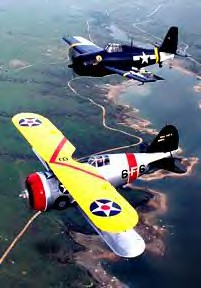The U.S. Navy's last biplane fighter, the F3F, was a direct outgrowth of the F2F whose performance was marred by poor directional stability and spinning characteristics which were caused by its extremely short fuselage. The Navy, however, felt that in other regards the F2F was an excellent design and, with refinement, would prove to be a first rate fighter. As a result, a contract was issued for the development of the XF3F-1. To correct the stability problems the fuselage was stretched 22 inches, from 21 ft 5 in to 23 ft 2 in, and the wing area was expanded from 230 to 260 sq ft. The prototype, Bureau # 9727, made its first flight on March 20, 1935 but was destroyed two days later when it broke up while testing terminal velocity dives.
The second XF3F-1, which was issued the same bureau number, made its first flight on May 9 and was also destroyed two days later when it failed to recover from a spin. The pilot, who survived the crash, reported that high speeds induced directional instability which in turn caused the aircraft to enter into a flat spin from which he was unable to recover.
A third aircraft was ordered, again bearing Bureau # 9727, and first flew on June 20, 1935. Testing was completed and an order was placed for 54 F3F-1s on August 4. Production aircraft were powered by 650 hp Pratt & Whitney R-1535-84 engines which allowed the planes a speed of 231 mph at 7500 ft. A small fin-like projection was added to the empennage to increase area and reduce stability problems. The first squadron to receive the F3F was Fighter Squadron 5B (VF-5B) stationed aboard the USS Ranger (CV- 4).
Realizing that the days of the biplane fighter were essentially over, the Navy, hoping to buy time until the development of the F4F was completed, ordered the XF3F-2 from Grumman on July 25, 1936. Major changes included replacing the Pratt & Whitney engine with a 950 hp Wright R-1820-22 (the larger diameter of this engine necessitated a cowling revision which changed the appearance of the aircraft), replacing the original-two bladed propeller with a constant pitch Hamilton-Standard three-bladed assembly, and increasing the rudder area to counter the increased engine torque. These changes led to an increased speed of 264 mph from the original 231, boosted the climb rate from 2050 to 2750 ft/min and expanded the service ceiling to 33,200 ft from 27,100. Eighty-one F3F-2s were ordered by the Navy and were used to equip VF-6 aboard the U.S.S. Enterprise and Marine squadrons VMF-1 and VMF-2. The 65th aircraft was modified on the production line to the F3F-3 standard, and subsequent aircraft finished as that model.
The final version, the F3F-3, came about because of delays in the development of the F4F. It incorporated a smaller diameter propeller, a modified cowling and a cockpit canopy similar to that used on the F4F. Only 27 of this version were ordered with the first aircraft being assigned to the carrier USS Yorktown (CV- 5). The entire series carried the same armament of one .30 cal. and one .50 cal. Browning machine gun mounted in the cowl.
By the end of 1941 none of the aircraft were in operational service, but 117 of them were distributed to various bases around the country for training and transport duties. The last plane, an F3F-2, was retired from flying service in November 1943.

Manufacturer: Grumman
Powerplant: 950 hp Wright R-1820-22
Length: 23 ft 2 in
Wingspan: 32 ft
Height: 9 ft 4 in
Wing Area: 260 sqft
Empty Weight: 3,285 lbs
Max. Weight: 4,795 lbs
Max. Speed: 264 mph
Ceiling: 33,200 ft
Ferry Range: 980 miles
Armament: Two 0.3-in guns
